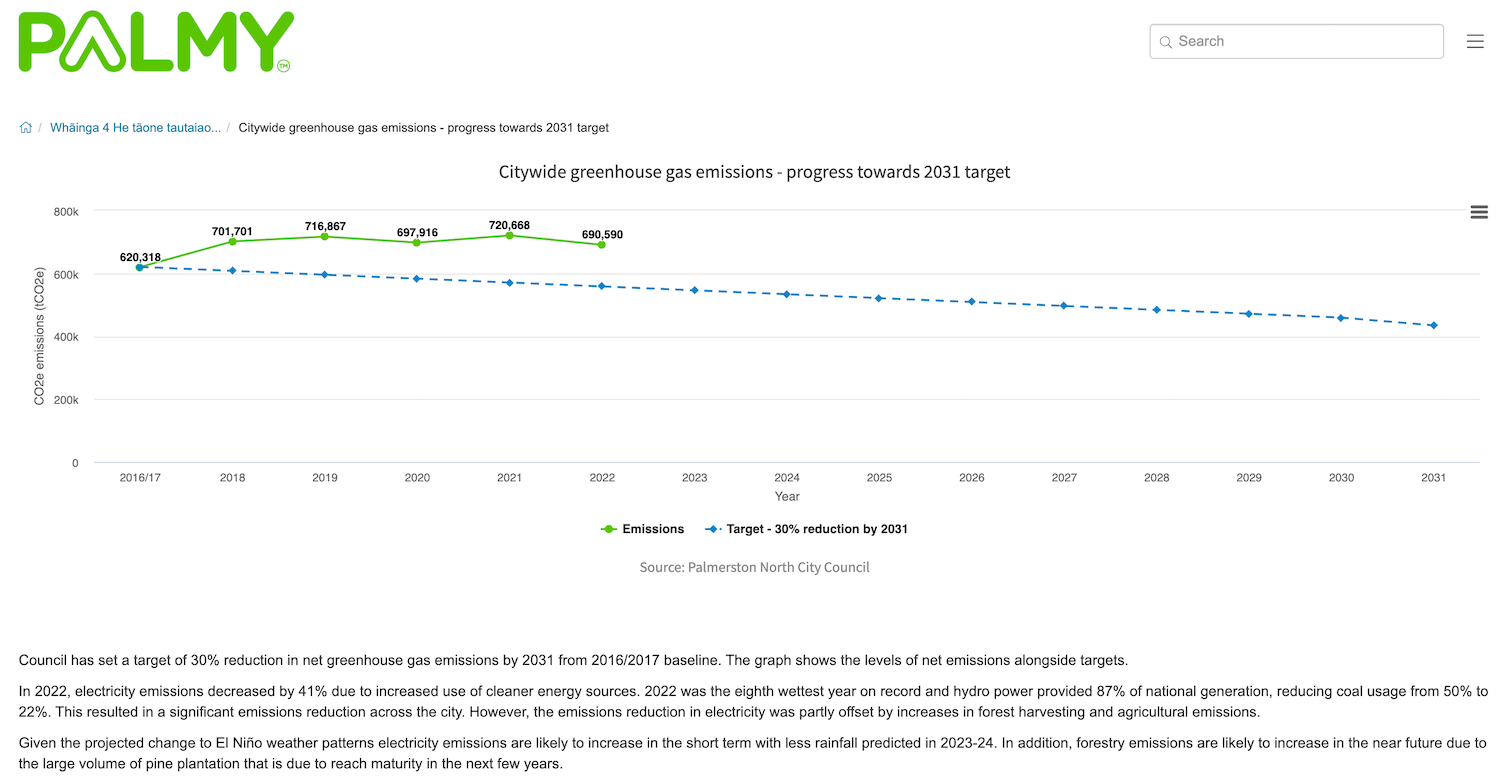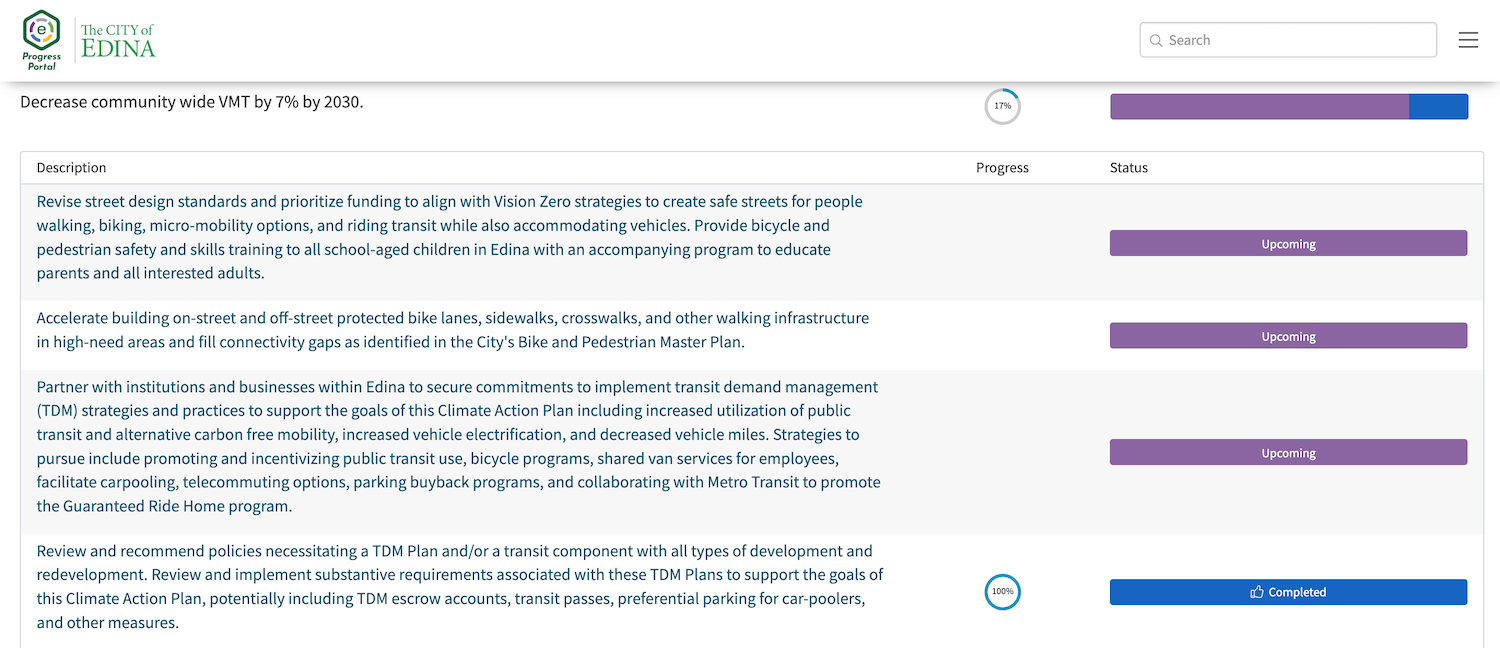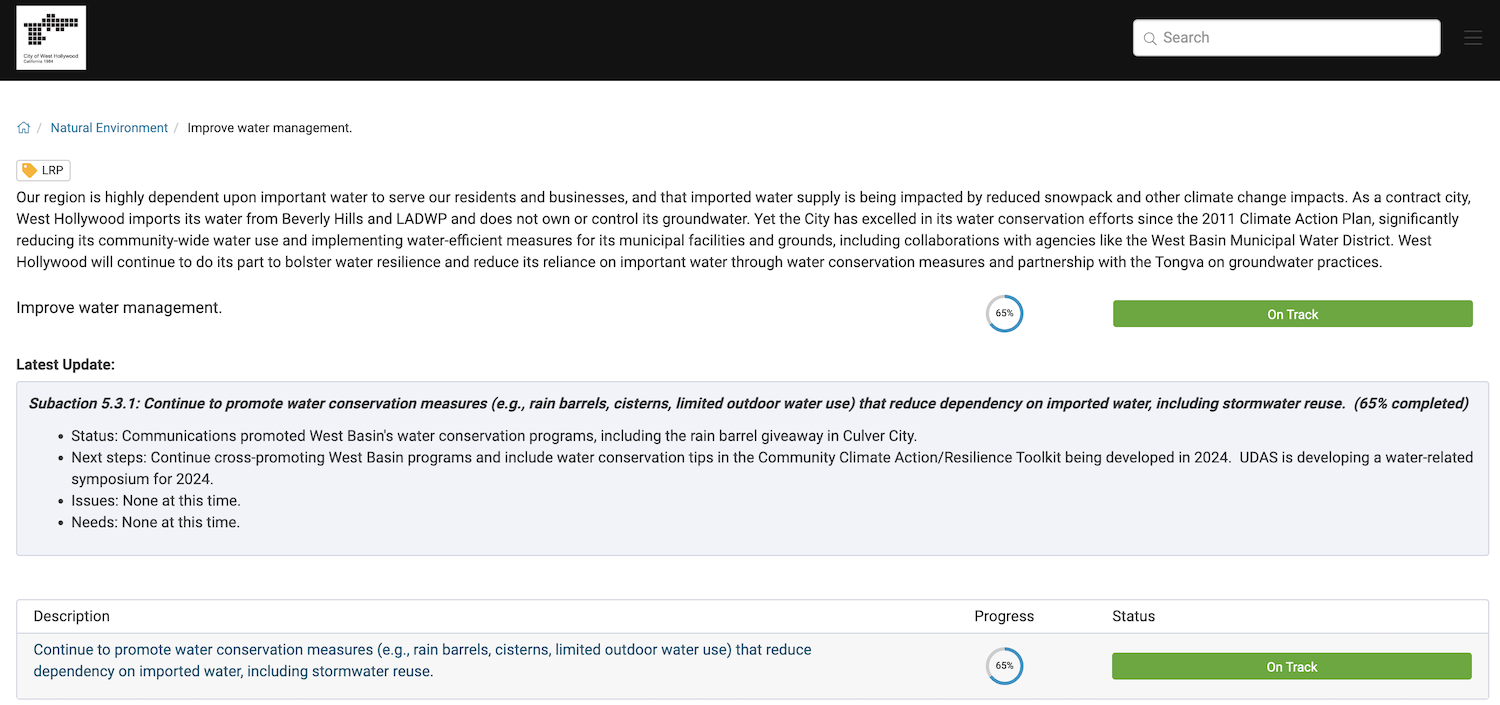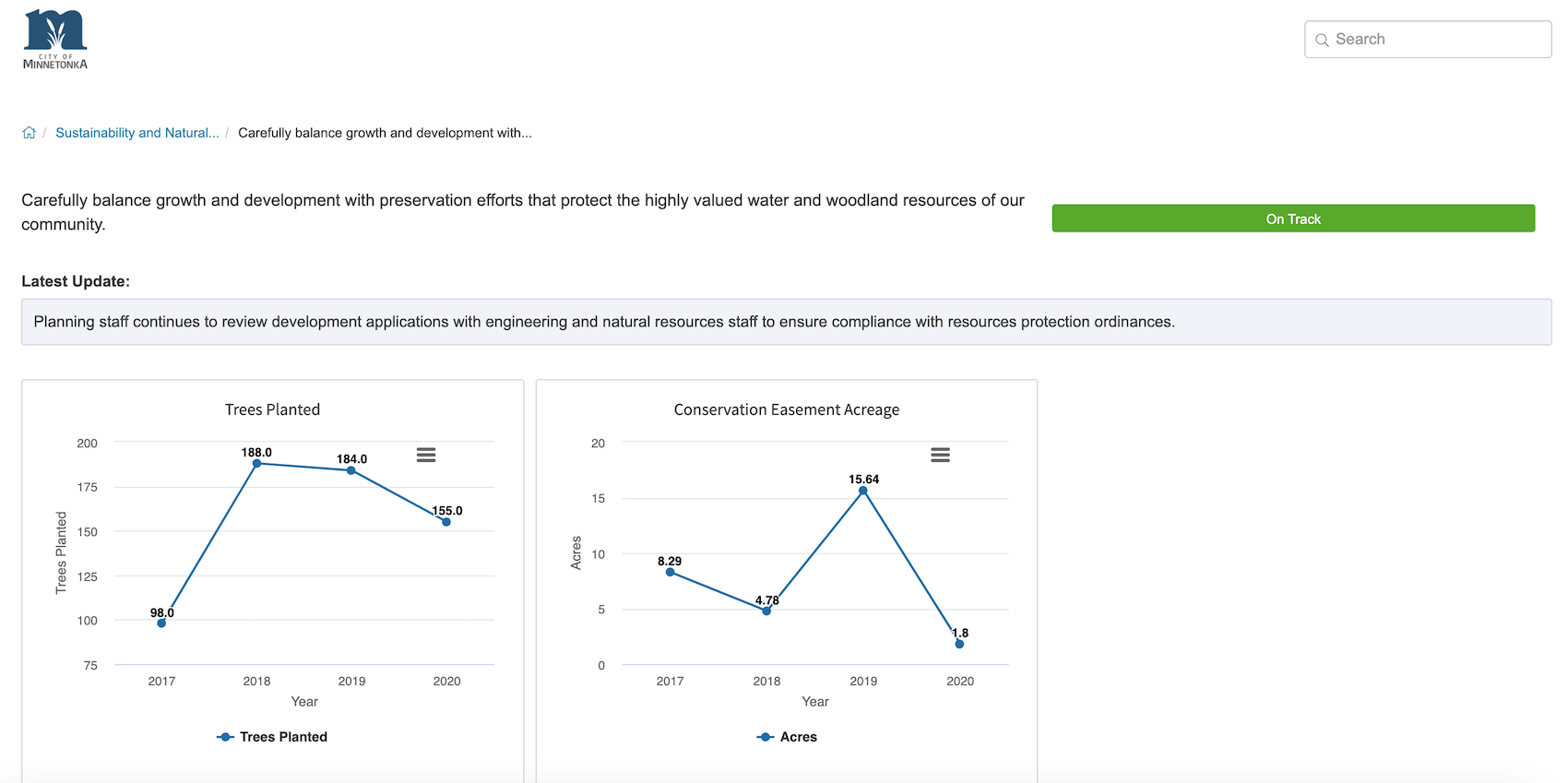
Contents
- 1 Local Governments, Wicked Problems, and Climate Action
- 2 The Role of Performance Measurement in Tackling Wicked Problems
- 3 Components of Successful Climate Action Performance Measures
- 4 Performance Measures and Climate Action Plans
- 4.1 Climate Action Plan Performance Measure: Greenhouse Gas Emissions Reduction
- 4.2 Climate Action Plan Performance Measure: Renewable Energy Usage
- 4.3 Climate Action Plan Performance Measure: Water Conservation
- 4.4 Climate Action Plan Performance Measure: Availability of Green Space/Percentage of Trees Planted
- 5 Climate Action Plan: Measuring Change With A Wicked Problem
- 6 Get the Guide ↓
Some challenges are so complex, interconnected, and stubbornly resistant to resolution that they defy traditional problem-solving approaches. These are known as “wicked problems.”
Originally coined by philosopher C. West Churchman, and popularized by social scientists and design theorists Horst Rittel and Melvin Webber in the 1970s, wicked problems are characterized by their multifaceted nature, lack of clear solutions, and tendency to generate unintended consequences.
In this series, we’ll look at how local government organizations are uniquely set up for tackling wicked problems, and why measuring performance is a key strategy in doing so!
And, because it’s Earth Day, we wanted to kick this series off with an exploration of climate change—one of the most glaring examples of a wicked problem.
Local Governments, Wicked Problems, and Climate Action
Climate change is no longer a distant threat; it is a pressing reality. We’ve talked before about the critical role that local governments play in taking climate action. But what are the markers of success, and what kind of performance measures should be at play?
How do cities, urban areas, counties, and other local government organizations know when they’re hitting the mark on their climate action plan?
In this post, we’ll take a detailed look at how cities are tackling the wicked problem of climate change through effective performance measurement strategies. We’ll highlight some of the best climate action plans, effective performance measures, and real-world examples of climate action by innovative local governments in North America and beyond.
The Role of Performance Measurement in Tackling Wicked Problems
Wicked problems are not just complicated. They are characterized by being inherently messy, involving multiple groups with conflicting interests, uncertain and changing variables, and shifting contexts. Climate change exemplifies the wicked problem archetype, as it encompasses a myriad of interconnected issues, including rising temperatures, extreme weather events, a lack of collaboration between major decision-making entities, biodiversity loss, and socioeconomic disparities. To take effective action against climate change means addressing virtually every societal system we have in the world.
On the plus side, while wicked problems may not have one definitive solution, they can be managed and mitigated through adaptive, agile, collaborative approaches. Local governments have a unique ability to create and adapt systems in an immediate and tangible way.
Performance measurement plays a crucial role in this process by providing local governments with the tools to track progress, evaluate the effectiveness of interventions, and adapt strategies in response to changing conditions. By measuring change and monitoring key indicators, cities can gain insights into the complex dynamics of climate change and make informed decisions to address its impacts.
Components of Successful Climate Action Performance Measures
We love talking about SMART actions (Specific, Measurable, Achievable, Relevant (and Resourced), and Time Bound), and those should all be a part of an effective climate action plan.
Relevance and Measurability are of particular importance for tackling a wicked problem like climate change. The measures chosen must be directly related to the goals and objectives outlined in your climate action plan. Whether it’s reducing greenhouse gas emissions, increasing renewable energy usage, or enhancing resilience to climate impacts, measures should align with your overarching objectives. Making sure they’re measurable is also important to allow for accurate tracking of progress and realistic targets and benchmarks.
But there are two additional components that should be included for climate change mitigation and climate action planning. They are:
Data Accessibility: Access to reliable data is crucial for effective performance measurement. Cities should invest in robust data collection and management systems to ensure the availability of accurate and up-to-date information.
Transparency: Transparent reporting of performance data fosters trust among community members as well as other cross-sector organizations and government agencies that may be involved in implementing climate action plans. Cities should strive for openness and clarity in their communication of climate action progress.
The plans that we will be exploring through the rest of this article make careful use of SMART performance measures, as well as being exceptional examples of data accessibility and transparency through their Envisio public dashboards.
Not sure how your community compares? Check out our new integration with Polco Track, for out-of-the-box community livability indicators around Natural Environment, and kick start your journey!
Performance Measures and Climate Action Plans
Let’s explore some of the best climate action performance measures, along with real-world examples of climate action plans from cities at the forefront of these efforts.
Climate Action Plan Performance Measure: Greenhouse Gas Emissions Reduction
Reducing greenhouse gas (GHG) emissions is usually the primary objective of climate action plans worldwide. Cities often measure their progress in this area by tracking the total emissions within their jurisdiction and setting targets for reduction. One effective measure is the per capita GHG emissions, which divides the total emissions by the city’s population to provide a standardized metric.
Example: Palmerston North, New Zealand
Palmerston North’s City Council has established a goal of achieving a 30% reduction in net greenhouse gas emissions by 2031 (from the baseline of 2016/2017). You can chart their progress on their public dashboard, which illustrates the levels of net emissions alongside these targets. In 2022, there was a notable 41% decrease in electricity emissions, attributed to the increased utilization of cleaner energy sources.
Climate Action Plan Performance Measure: Renewable Energy Usage
Transitioning to renewable energy sources plays a crucial role in decarbonizing the economy and reducing reliance on fossil fuels. Cities can measure their progress by tracking the percentage of energy consumed from renewable sources, such as wind, solar, and hydroelectric power.
Example: City of Edina, Minnesota
The City of Edina collected data across eight distinct climate sectors:
- Transportation and urban planning
- Building and energy usage
- Waste management
- Water and sewage systems
- Local food production and agricultural practices
- Green spaces and forestry
- Climate-related health and safety
- Climate economy
They measure performance carefully across all these strategic areas, with each one breaking down into specific goals that are distinctly measurable. For instance, let’s take a look at their strategic action regarding transportation, “Decrease community wide VMT by 7% by 2030.”
As you can see, this particular goal is measured through the implementation of specific actions. They have data around partnering with businesses and institutions to incentivize public transit use, and they’re creating shared van services for employees. They’ve been increasing opportunities for car-poolers, and improving non-car infrastructure through specific, measurable programs.
Climate Action Plan Performance Measure: Water Conservation
As climate change brings about more frequent and severe weather events, cities must enhance their resilience and adaptability to withstand and recover from these impacts.
Commonly tracked and important performance indicators for resiliency are around water conservation efforts.
With wicked problems, exacerbation of one area typically creates more problems in another, because the solutions are not discrete. They are interconnected.
As climate change exacerbates water scarcity and strains existing resources, effective conservation measures become paramount for mitigating the impacts on communities. By reducing water consumption, municipalities not only contribute to broader climate resilience but also alleviate pressure on ecosystems and support sustainable water management practices.
Some examples of water conservation performance measures include:
- Per capita water consumption: Tracking the average water usage per person over time to gauge the effectiveness of conservation efforts.
- Percentage of households enrolled in water conservation rebate programs: Monitoring the uptake and impact of rebate programs that incentivize residents and businesses to invest in water-saving technologies such as low-flow fixtures, efficient irrigation systems, and rainwater harvesting.
- Number of reclaimed water systems (over a set period of time): Tracking the expansion and utilization of reclaimed water systems for non-potable uses such as irrigation, industrial processes, and toilet flushing to reduce demand on freshwater sources.
These are only three examples, but there are many more. If you want to do a deep dive into a customer of ours that really knows their stuff about water conservation, we invite you to take a peek at Sonoma County Water Agency. Their strategic plan is aimed at staying ahead of the climate curve and the impacts it will have on water access in a changing climate. They are a great resource for learning more about municipal water conservation.
As for a city with concrete action plans around adaptability and water conservation… allow us to introduce you to West Hollywood.
Example: City of West Hollywood, California
West Hollywood is trying to tackle the reality of their imported water supply, which has been impacted by a diminished snowpack and other effects of climate change. As a contract city, West Hollywood relies on water imports from Beverly Hills and LADWP, without direct control over groundwater resources.
They’ve demonstrated remarkable progress in water conservation efforts since the launch of their 2011 Climate Action Plan. Through collaborative efforts with agencies such as the West Basin Municipal Water District, West Hollywood has significantly decreased community-wide water consumption and implemented water-efficient practices in municipal facilities and grounds, including creating better opportunities for collaboration with Indigenous people, such as the Tongva people, on groundwater management practices.
Climate Action Plan Performance Measure: Availability of Green Space/Percentage of Trees Planted
Increases in green space not only enhance the aesthetic appeal of cities but also provide numerous environmental benefits. Some of these benefits include carbon sequestration, air purification, and heat island mitigation. Cities can measure their progress in this area by tracking metrics such as tree canopy coverage, or green space per capita.
Example: City of Decatur, Georgia
The Decatur team is weaving climate policies into broader initiatives that tackle transportation, housing, and equity. Their strategic plan involves strengthening partnerships with governments and non-profits at all levels, to further amplify their overall capacity for collective action. Decatur also recognizes that a failure to act will exacerbate existing social and economic disparities, burdening those already marginalized. Action on climate change, as outlined in their strategic plan, is not just a matter of environmental stewardship, but of social justice.
One of the areas they are working on is creating processes and incentives for preserving (and increasing) green spaces in the city. Some of this work is related to sustainable building and infrastructure, and other plans are related to literally increasing the amount of usable green space and parkland available to their community.
Example: City of Minnetonka, Minnesota
Another pioneering city in measuring climate action and impact is Minnetonka. They measure trees planted and conservation acreage, and are working to improve their forested areas.
But that’s not all!
The Minnetonka team also measures the level of resident satisfaction with how climate action and environmental stewardship information is disseminated! This is climate action matched with concrete performance measures, and transparency, at its best.
Climate Action Plan: Measuring Change With A Wicked Problem
Measuring trends and change is essential for tackling any wicked problem, and is especially important for effective climate action planning. By employing the right performance measures, local governments can track their progress, evaluate the effectiveness of their initiatives, and make data-driven decisions to accelerate the transition to a cleaner, more resilient future. From reducing greenhouse gas emissions to enhancing urban green spaces, the examples highlighted here demonstrate the diverse strategies cities are employing to combat climate change.
Get the Guide ↓
Action is the antidote to hopelessness when it comes to wicked problems. Download our free guide on How to Develop Local Government Performance Measures and let us help you take steps towards actionable solutions.












